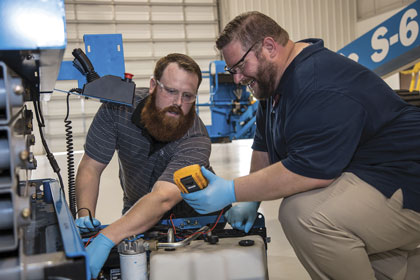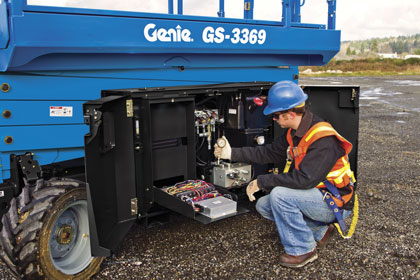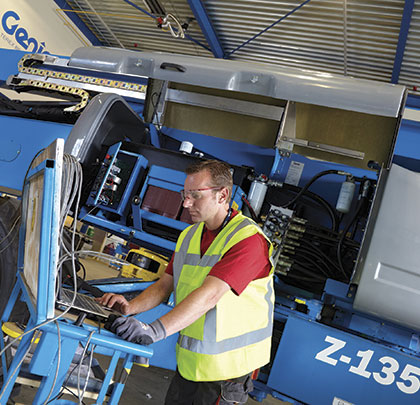In theory, everyone knows that preventive maintenance is the key to keeping aerial equipment, including boom lifts, scissor lifts, and telehandlers, running at peak efficiency and to getting a better return on invested capital (ROIC). But in practice, preventive maintenance routines are often postponed, or even neglected, in order to keep lifts working in the field.
The reality is that performing routine maintenance tasks can save contractors a lot of money. Most regular maintenance tasks can be handled in-house by anyone experienced with the aerial equipment and familiar with a machine’s particular sounds and performance.
MAKE IT A HABIT
Preventive maintenance is a commitment that needs to be made before, during, and after every job. The maintenance tasks should be simple and easy to follow, yet provide attention to detail—it is easier to deal with things little by little rather than have something fail and face the consequences.
For example, before a lift goes out on a job it is important to check the water levels in the battery. The condition of the battery is directly linked to the life and longevity of the machine. It is also important to check the oil and coolant levels.
The next step is to walk around the machine, checking for leaks and making sure all the machine’s systems are lubricated and functioning properly—have a grease gun handy to lubricate the systems if necessary.

Featured Image: Properly maintaining equipment ensures that each machine is on par when it’s working in the field, minimizing the risk of jobsite incidents due to equipment issues.
Above: To keep equipment in peak working condition, operators and/or technicians need to perform all of the required daily tasks recommended by the equipment manufacturer.
While completing the visual inspection, be sure to also check:
- Tire wear and condition
- Fastener tightness
- Measurements of the wear pads
- Hose and wiring routing for chaffing
- Component cover latches and hinges
- Decal legibility
- Cable track integrity
- Banjo keeper bolt integrity
At the end of a job, it is important to wash down the entire unit, including underneath the machine—removing any dirt, dust, sand, or other jobsite material that can accumulate and contaminate the machine—and lubricate again, according to the manufacturer’s lubrication plan. During this process, do a visual check for any external or internal damage, repairing and replacing as necessary. This is a good time to take care of paint touch-ups.
A LONG-TERM COMMITMENT
Good operating condition and extended life expectancy of aerial equipment are largely influenced by regular care and maintenance. This goes beyond the daily care and feeding of the machine’s systems, it also includes longer-term attention.

Bottom: Equipment operators depend on their aerial lift to work and function properly and safely every time they use it, for every job they do.
Every 6 months, contractors need to have an open discussion with their equipment operators about how the lift is being used day in and day out, as well as how it’s performing in the field. Also at this point, look at the maintenance records to spot any patterns—it is important to look at what components are failing and to determine why, how, and when they failed. It is also important to know which components are holding up over time and to analyze those trends. Too often, the little things can be an indication of larger problems. These warning signs should never be ignored.
Some, or all, of these maintenance tasks will affect the residual value and on-the-job performance of the machine, as well as will influence your customers’ perceptions of your rental business and equipment. ■
About The Author: Galen Wickstrom is the Genie National Accounts Vice President, Terex AWP. For more information, visit www.genielift.com.
_________________________________________________________________________
Modern Contractor Solutions – December 2016
Did you enjoy this article?
Subscribe to the FREE Digital Edition of Modern Contractor Solutions magazine.



